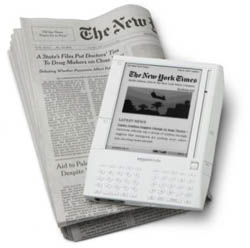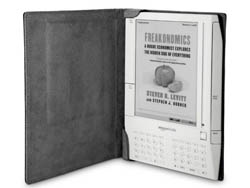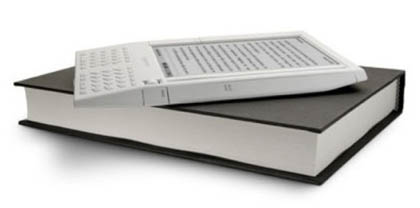 What is a Kindle?
What is a Kindle?
First off, the Kindle is Amazon’s entry into the ebook reader market. It joins the Sony PRS-505 Reader which has been around for awhile but, it adds a lot of interesting features such as a free built-in wireless connection that allows you to tap into Amazon’s online bookstore from just about anywhere you can access Sprint’s EVDO cellular data network.
The Kindle is similar to the Sony Reader. The Kindle is 7.5 inches high by 5.3 inches wide by 0.7 inch deep and only weighs 10.3 ounces. That is about the same as your average paper back. Both devices have 4.9-by-3.6-inch (6-inch diagonal), 600 x 800-pixel screens. The screen on both readers uses a technology call E ink. E Ink is an electrophoretic display.
From Wikipedia:
An electrophoretic display is an information display that forms visible images by rearranging charged pigment particles using an applied electric field.
E Ink is a type of Electronic paper display. From Wikipedia:
Electronic paper, also called e-paper, is a display technology designed to mimic the appearance of ordinary ink on paper. Unlike a conventional flat panel display, which uses a backlight to illuminate its pixels, electronic paper reflects light like ordinary paper and is capable of holding text and images indefinitely without drawing electricity, while allowing the image to be changed later.
There are several different technologies to build e-paper, some of which can use plastic substrate and electronics, so that the display is flexible. It is considered more comfortable to read than conventional displays. This is due to the stable image which does not need to be constantly refreshed, the large viewing angle, and the fact that it uses reflected ambient light. It has a similar contrast ratio to that of a newspaper and is lightweight and durable, however it still lacks good color reproduction.
 One annoyances of E Ink technology is that the screen takes a second to refresh. The result is it tends to blink when you change the page. Amazon has done a good job of minimizing this so it isn’t that distracting but, for those that have not used an E Ink display before, it might cause unnecessary concern. Considering you can read the screen in direct sunlight, the trade-off seems worth it.
One annoyances of E Ink technology is that the screen takes a second to refresh. The result is it tends to blink when you change the page. Amazon has done a good job of minimizing this so it isn’t that distracting but, for those that have not used an E Ink display before, it might cause unnecessary concern. Considering you can read the screen in direct sunlight, the trade-off seems worth it.
Amazon opted not to use a backlight which might strain the eyes during long sessions. The result is that you’ll need a well lit reading environment just like you would with a real book. The Kindle has a 185 MB of user-accessible internal memory and is expandable with the use of SD cards. Memory cards up to 4GB are supported. That is a lot of books. The Kindle also supports playing MP3s and Audible audio books. The MP3 player is a little restricted in that you can’t select which MP3 to play. It will only play them randomly. Hopefully this will be fixed in a future firmware update but, for now, that feature is pretty useless.
Navigating the Kindle interface is pretty easy. There is a home button that takes you to the main list page of your content. There is a scroll wheel that you can use to select lines of text and menu items along with next page buttons on both sides of the device. There is a pervious page button on the left side and back button on the right. Altogether, navigating is pretty intuitive. When you are viewing the home page, a click of the scroll wheel allows you to sort the list of your content by author, date, or title and to show just books or periodicals. You can bookmark key passages of what you’re reading, and (using the keyboard), make, edit, and export notes. The Kindle also saves your place when reading anything, so you can always pick up where you left off. One of better features is the built in dictionary. You can use the scroll wheel to select a line of text on the page. By default the dictionary will look up all the words on a selected line so you don’t have to worry about selecting a specific word or using the keyboard.
 One of the Kindle’s main advantages over the Sony reader is the built in EVDO cell connection. This is included mainly to allow you to download purchased content from Amazon without the need for a computer or too be in range of a Wi-Fi network. Luckily, there is no charge for this connection and Amazon was nice enough to include a basic web browser. The browser is fairly slow and doesn’t handle link and image rich web pages very well but, if all your are looking for is a quick answer, it does the job. One of the main features of the built in browser is the direct access to Wikipedia. Basically you have an entire encyclopedia with you at all times. Another cool feature is by pressing Alt + 1 you are taken to google maps which, in conjunction with cell triangulation, using the built it radio, can roughly show you where you are. Sort of a poor man’s GPS.
One of the Kindle’s main advantages over the Sony reader is the built in EVDO cell connection. This is included mainly to allow you to download purchased content from Amazon without the need for a computer or too be in range of a Wi-Fi network. Luckily, there is no charge for this connection and Amazon was nice enough to include a basic web browser. The browser is fairly slow and doesn’t handle link and image rich web pages very well but, if all your are looking for is a quick answer, it does the job. One of the main features of the built in browser is the direct access to Wikipedia. Basically you have an entire encyclopedia with you at all times. Another cool feature is by pressing Alt + 1 you are taken to google maps which, in conjunction with cell triangulation, using the built it radio, can roughly show you where you are. Sort of a poor man’s GPS.
Downloading books wirelessly to the Kindle is generally a very pleasant experience. You can search for titles or authors in the Kindle Store or scroll through the national and Kindle bestsellers lists (Amazon is currently offering more than 90,000 titles, including 90 percent of the current New York Times bestsellers).
Kindle is compatible with a few file types. Most files have to be converted. Amazon provides you two ways to convert your files: you can either send attachments wirelessly to the device’s personal e-mail address, which will cost you $.10 per attachment or you can send them to a “free” Kindle e-mail address that you access via your Windows or Mac OS computer and then transfer the converted files to your Kindle manually via USB.
By default the Amazon Kindle supports the following formats:
|
|
Folder |
Recognized File Types |
|
|
|
documents |
Kindle (.azw), text (.txt), Mobi (.mobi*, .prc*) |
|
| * Files containing digital rights management software will not be readable | |||
The document support is my main complaint about the Kindle. There is no reason it shouldn’t natively support pdf’s.
What is a Kindle good for?
Besides the obvious combination of an Amazon discount coupled with instant delivery (“A New Earth” is 24.99 for the print version at the Barns and Noble on the corner and only 7.99 on the Kindle and I don’t have to get in the car) I see the main advantage being reference material. Wouldn’t it be nice to have all the documentation for your job or project at your finger tips? In the case of computer manuals, having a device that is not tied to the system you are working on is a big advantage.
If you need a more technical price difference example than Oprah’s latest book club selection , “WordPress for Dummies” is 9.99 on the Kindle and 24.99 in print at Barns and Noble.
I use my Kindle mainly to store the mountain of documentation that I need to keep on hand to perform my day to day job. Having this content in a easy to read, searchable, and portable format is a god send and more then justifies the price. Sure the Kindle excels at allowing you to read for fun but, one tends to only read a work of fiction once and then maybe let someone else borrow it. The DRM format in use by Amazon prevents this so, with that restriction in place, it is hard to justify the 400.00 price tag for fiction reading unless you read a large number of books a week. So many that the discount and convenience justify the cost.
Unfortunately, by default, the Kindle doesn’t natively support the formats you are most likely to have all your personal documentation in so document conversion is a must.
Converting your documents to work on the Kindle.

Convert encrypted Mobipocket reader files to work on the Kindle.
First, lets work on your existing ebook library. As noted in the table above, by default the Kindle will not support encrypted Mobi ebooks. That kind of stinks seeing the library system here allows you to check out Mobi encrypted ebooks for 21 days. It would be nice to be able to use this services with the Kindle. Enter
Igor has written a couple of python scripts to help you convert your Mobi ebooks which can be found here.
Convert pdf’s to work on the Kindle
Next up is .pdf’s. Your first option is to mail the pdf to yourname@kindle.com and have Amazon convert it for you at a cost of .10 cents per file. I’m sorry but, I want to read all my tech manuals and other pdf formated content without having to pay a bill so, I did a little research and found that Mobi offers a free program that you can use to create .prc files. One of the many supported import formats is .pdf. The other supported formats are .doc, .txt, and HTML. Problem solved. Simply use the Mobipocket Creator 4.2 Publisher Edition to import your pdf’s.
The Mobipocket Creator 4.2 Publisher Edition can be downloaded here.
What about other formats such as .xls, .rtm, etc..? Well, if you can create a pdf then it can be moved to your Kindle using the method above. To do this on Windows, Linux and OSX have native support for pdf creation, I use the free program PDFCreator. PDFCreator installs a printer on your Windows system that will create pdf’s from any program that has a print function. After installing PDFCreator simply, open up the file you wish to convert in whatever program you normally use to view the file and select the PDFCreator printer when you go to print the file. It will convert the file to pdf and ask you where to save it. You can then take the resulting .pdf and import it into the Mobipocket Creator to create your .prc file. Finally, you need to transfer the .prc file to the documents folder on your kindle using a USB connection.
Convert .lit ebooks to work on our Kindle.
Microsoft uses the .lit ebook format for it’s MS Reader software. I have found the CD included with some of my manuals from Mircosoft Press include an eletronic version of the manual in this format.
You can convert .lit formated files to pdf using the ABC Amber LIT Converter which, is free. Once you have converted the file to pdf you can use the process above to convert it to a .prc file and move it to your Kindle.
Convert .chm files to work on your Kindle.
The .chm format is Microsoft’s Compiled HTML Help format. This is the format that most of the help files and online manuals in Windows are in. Wouldn’t it be nice to take those manuals and move them to an easier to read device then your computer screen? I tend to do this with all the documentation that comes with Visual Studio. I have also run into this format on the CD’s included with my printed manuals.
Again it is Process Text Group to the rescue with its ABC Amber CHM Converter, which is free to try for 30 days. Like the utility above, this one lets you convert .chm files to pdf. Again, use the pdf to .prc method above to make the file compatible with the Kindle.
Files in the .chm format were never meant to be read outside of the Windows help system so, by default they contain navigational images for switching pages. On the Kindle these are unnecessary and generally just make the presentation messy. The CHM converter software has an option to discard these images while doing the conversion.
In the utility Select Tools – Options – Misc, and select the “remove Previous and Next buttons” option.
